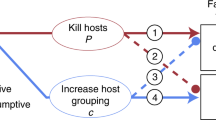Abstract
As prisoners in their living habitat, parasites should be vulnerable to destruction by the predators of their hosts. But we show here that the parasitic gordian worm Paragordius tricuspidatus is able to escape not only from its insect host after ingestion by a fish or frog but also from the digestive tract of the predator. This remarkable tactic enables the worm to continue its life cycle.
Similar content being viewed by others
Main
The induced suicide of crickets infected by gordian worms is one of the best known examples of parasite manipulation of host behaviour1. Adult gordian worms are free-living in water, where they mate as a knotted mass of multiple individuals. Emergence from the host occurs only after the cricket enters the water (for movie, see supplementary information) and may take as long as 10 min owing to the large size of the worm1. During this time, the cricket is active at the surface and attractive to aquatic predators such as fish and frogs (F.T., unpublished observations). Death of the worm would be expected to result from generalist predation upon the host at this stage unless the parasite were capable of an antipredator response.
Few parasites have their own predators, although they are victims of those of their hosts. Predation upon a host may shape parasite life history in two important ways. First, increased predation may select for increased parasite virulence2,3: for example, parasite development can speed up to minimize the period of host occupancy4. Increased virulence may also take the form of manipulating the host's behaviour5, for example to remove it from sources of predation6,7. Second, predation may affect parasite life history if the predator becomes incorporated into the life cycle8,9,10.
We investigated the response of gordian worms to predation on their host. Under laboratory conditions, we found that crickets that harboured or were expelling gordian worms were often eaten by generalist predators — fish (trout (Oncorhynchus mykiss), perch (Lepomis gibbosus), bass (Micropterus salmoides)) and frogs (Rana erythraea). In none of the 477 predation events that we observed did the predator regurgitate the cricket. Remarkably, the worm escaped predation by wriggling out of the mouth, nose or gills of the predator that had consumed its host (Fig. 1). This escape was recorded from trout (18%, n=141), bass (26%, n=292), perch (22%, n=27) and frogs (35%, n=17) (for methods, see supplementary information).
a, Gordian worm (arrow) emerging from a host cricket; b–d, gordian worms (arrows) emerging from a frog (b), a trout (c) and a bass (d) after ingestion of the host insect by these predators. For movies, see supplementary information.
The mean time until full emergence was 8.6 min (518±208 s, n=72). The maximum time was 28 min, when the predator repeatedly tried to swallow the worm while it was escaping. If a worm did not start to emerge from the mouth, gills or nose within 5 min, it failed to escape — dying, presumably, in the hostile environment of the predator's stomach. To our knowledge, this escape response by a gordian worm is the first example of a parasite or any organism surviving predation in this way.
References
Thomas, F. et al. J. Evol. Biol. 15, 356–361 (2002).
Day, T. Proc. R. Soc. Lond. B 269, 1317–1323 (2002).
Ebert, D. & Herre, E. A. Parasitol. Today 12, 96–101 (1996).
Harvey, J. A. & Strand, M. R. Ecology 83, 2439–2451 (2002).
Read, A. F. Trends Microbiol. 2, 73–76 (1994).
Moore, J. Parasites and the Behavior of Animals (Oxford Univ. Press, Oxford, 2002).
Brodeur, J. Norw. J. Agr. Sci. 16, 147–153 (1994).
Choisy, M., Brown, S. P., Lafferty, K. D. & Thomas, F. Am. Nat. 162, 172–181 (2003).
Parker, G. A., Chubb, J. C., Ball, M. A. & Roberts, G. N. Nature 425, 480–484 (2003).
Lafferty, K. D. Parasitol. Today 15, 111–115 (1999).
Author information
Authors and Affiliations
Corresponding author
Ethics declarations
Competing interests
The authors declare no competing financial interests.
Supplementary information
Supplementary Video 1
A gordian worm (Paragordius tricuspidatus) leaves its cricket host (Nemobius sylvestris). (MOV 1987 kb)
Supplementary Video 2
A gordian worm slides out of a frog’s mouth, the frog (Rana erythraea) having eaten the cricket in which the worm was living. (MOV 2598 kb)
Supplementary Video 3
A gordian worm slides out of a trout’s gill, the trout (Oncorhynchus mykiss) having eaten the cricket in which the worm was living. (MOV 838 kb)
Rights and permissions
About this article
Cite this article
Ponton, F., Lebarbenchon, C., Lefèvre, T. et al. Parasite survives predation on its host. Nature 440, 756 (2006). https://doi.org/10.1038/440756a
Received:
Accepted:
Published:
Issue Date:
DOI: https://doi.org/10.1038/440756a
This article is cited by
-
Manipulative neuroparasites: uncovering the intricacies of neurological host control
Archives of Microbiology (2023)
-
Search performance and octopamine neuronal signaling mediate parasitoid induced changes in Drosophila oviposition behavior
Nature Communications (2022)
-
Parasite transmission between trophic levels stabilizes predator–prey interaction
Scientific Reports (2018)
-
Direct consumptive interactions between mammalian herbivores and plant-dwelling invertebrates: prevalence, significance, and prospectus
Oecologia (2017)
-
The brain’s Geppetto—microbes as puppeteers of neural function and behaviour?
Journal of NeuroVirology (2016)
Comments
By submitting a comment you agree to abide by our Terms and Community Guidelines. If you find something abusive or that does not comply with our terms or guidelines please flag it as inappropriate.




